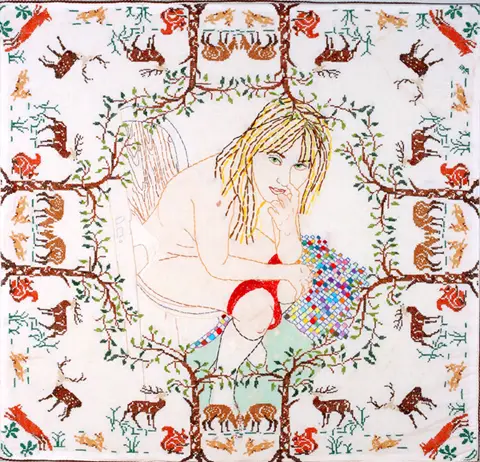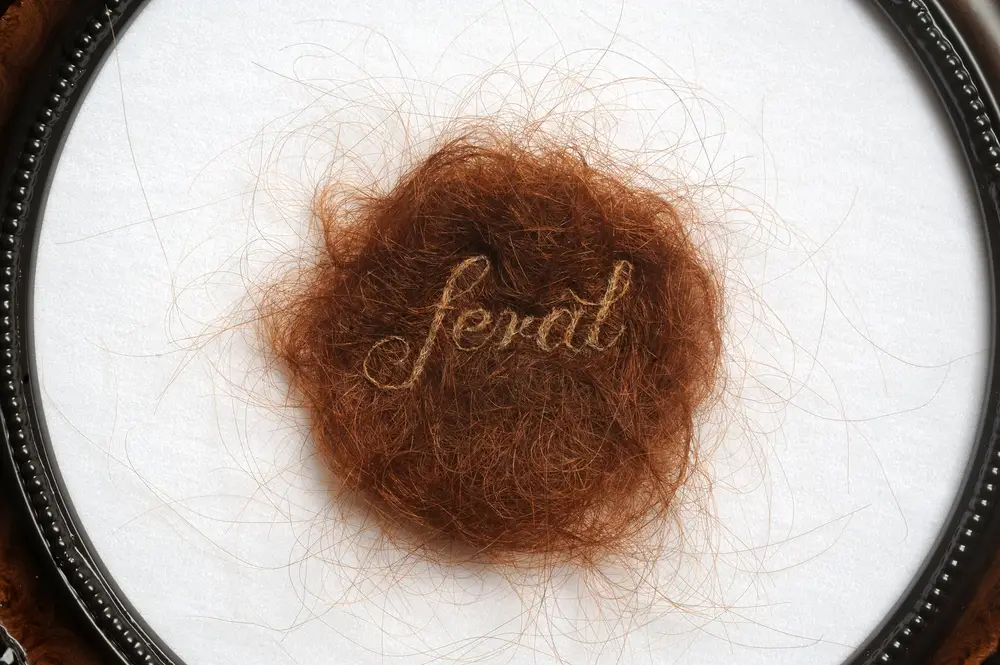
Rebecca Harris is a mixed media artist from Plymouth, England.
“In May 2015 the Eden Project in Cornwall will be opening their new permanent exhibition ‘Invisible You: the Human Microbiome’ supported by the Wellcome Trust. A collection of various artists have been selected to bring the invisible world of the microbes that live in our bodies to life for the viewers. Artist, Rebecca D. Harris, whose work is predominately textile based, was selected for her proposal to create a hand and machine embroidered wall hanging which explores how our microbial communities form us. In particular, her focus is on the very start of our lives when we are sterile in our mothers’ wombs and the pregnant figure portrays the body as a microbiome and its effects on our physical landscape. When we are born our bodies are 100% human, by the time we are adults our human cells are outnumber 10:1, resulting in us being 90% microbes!
“Our bodies are an enormous microbial community, which works together to keep us healthy and as such we are referred to as an eco-system. Using this analogy of the body being like a geographical area, Rebecca established a method of representing the twodimensional body with a three-dimensional effect similar to that of a topographical map’s contour lines. Using medical imaging techniques (MRI), the artist traces around each ‘slice’ of the human body and the ‘landscape’ created is the chartered area of trillions of microbes to be explored and discovered.
“In talking about the process Rebecca says “before the work even began on fabric there were many painstaking hours, days and weeks using the medical imagery software and Adobe Illustrator. Each line has to be perfect, and in many cases I drew much of the lines from scratch. I did not have a full figure scan, the figure you see is a combination scans on various parts of the body brought together. There were also none that had breasts so I had to draw these myself. Furthermore, it’s important to protect the identity of the person and so a lot more manipulation is made to obscure them.
“Once this was complete I printed off the whole life-size image on many pieces of A4 paper. Using the technique I learned through a masterclass with Alice Kettle I would work from the rear of the piece, winding embroidery thread into the machine’s bobbin. This allowed me to follow my printed template which was much harder than it sounds, and required lots of editing, tidying up etc afterwards.
“The first stage of the hand embroidery started with the baby, using just normal sewing thread I wanted to create a flat, drawn like image. As this area will not have any further embroidery on it I wanted it to have a stillness and lack of texture to fully represent the sterile nature of the womb during pregnancy.”
“Moving on from this stage Rebecca is currently hand embroidering many thousands of French knots. For which she wanted the ‘terrain’ of the body to have a beautiful and seductive surface of ‘colonies’ occupying the ‘landscape’. They represent the microbial communities that our bodies are covered in and are part of. They are bright and tactile, and so, enable the viewer to engage with the positive aspects of our microbial colonies. All too often the focus is placed on the microbes that harm us. Our bodies are not blemished by the microbes, but like what the artist is doing with the embroideries, they are embellishments, a way to seeing the positive side of the microbes we share our existence with, and more so, owe our existence to.
“The colours and crowding of stitching is in no way random. Working with Professor Michael Wilson, from the department of Microbiology at University College of London, the pair are working as a team to best represent the different types of microbes that inhabit the surface of our skin. Using data and images from Professor Wilson, Rebecca is interpreting the best way to represent how the microbes colonise in certain areas and to what extent they do so. Rebecca adds: “it’s not that you need to have a ‘key’ next to the work or even know what, where or why, it’s just that it needs to give the idea that we have a huge variety of microbes on us and they like some places better than others!”
“Rebecca is due to spend many more hours to complete this piece, and as she has become rather experienced at creating French knots and as the majority of the work does not require a great deal of concentration she wants to get share this process with others. The artist has therefore decided to go out into the community to sit and sew, and allow interested parties to then come and enquire about the ideas and science behind the work. “I am very interested in breaking down that wall between artist and viewer and not leaving the work to the grand reveal”.
“To start, Rebecca will be in the Wellcome Trust building (next door to the Wellcome Collection) this Friday (30th January) in the morning and afternoon for some sit and sew sessions. Then on the 10th and 11th February she will be at The Core, Eden Project’s education building and the following weekend, 14th and 15th February, at her home studio in Launceston, Cornwall. This joining of science and art is by no means a new venture, as it is seen as early as the Renaissance period with Leonardo da Vinci. It is however, an exciting and interesting way to take something as domestic as the hand stitched knot, done many thousands of times over, to represent our invisible world. It engages the viewer with not only science and art, but what it is to have a human body and for us to start exploring the exciting world of our microbiome.
Where textiles are used to conceal the body, Rebecca uses them to reveal.
I love science stitching, the use of our favourite tools to explore something that might be technical and yet at the same time quite personal. Rebecca’s pieces give us a new insight into the shapes and composition of our bodies, reminding us what a precious ecosystem we are. It’s great to see this project grow and big props to Rebecca for getting embroidery into such prestigious establishments.
If you’re able to join Rebecca on 30th January or any of the other dates, I would encourage you to do so. It can only be a good thing. Visit her website to keep up with this fascinating project!











